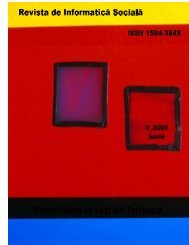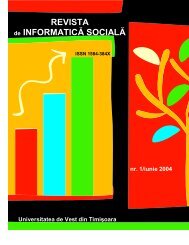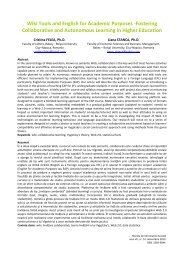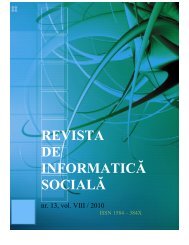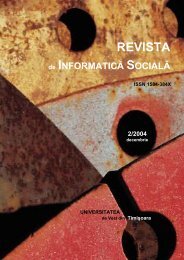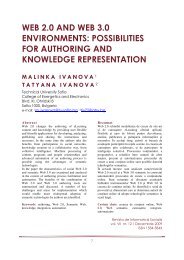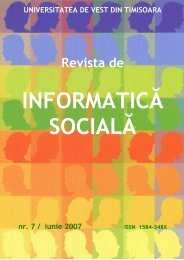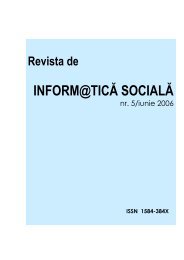No 14 - Journal of Social Informatics / Revista de Informatica Sociala
No 14 - Journal of Social Informatics / Revista de Informatica Sociala
No 14 - Journal of Social Informatics / Revista de Informatica Sociala
You also want an ePaper? Increase the reach of your titles
YUMPU automatically turns print PDFs into web optimized ePapers that Google loves.
It’s interesting to compare this with data related to the general population (Istat, 2008), whichshows that on average the television is by far the most preferred media in Italy, but also that peopletend to watch it massively; only the 2% <strong>of</strong> the overall national population <strong>de</strong>clares to watchtelevision less than one hour every day, the 11.8% watches it between one and two hour, the 26.1%between two and three hours every day, the 19.3% between three and four hours, the 10.4%between four and five hours and the 12.1% for more than five hours every day. Clearly, it seemsthat our target population is less inclined to watch television than the national average. We cansomehow take this to mean that a sort <strong>of</strong> substitution effect is taking place here, with rates <strong>of</strong> usage<strong>of</strong> new media increasing and at the same time <strong>de</strong>clining uses <strong>of</strong> traditional media among ourpopulation <strong>of</strong> university stu<strong>de</strong>nts. Data concerning the radio and the books seems to provi<strong>de</strong>corroborating evi<strong>de</strong>nce in favour <strong>of</strong> this assumption.As far as the use <strong>of</strong> the radio is concerned, we can see that in 2008 the 74.8% <strong>of</strong> our sample listenedto it less than 5 hours per week, and only the 11.6% <strong>of</strong> the sample spent between 5 and 10 hours perweek listening to it (Figure 3). Once again, these data seem to be significantly lower than thenational average, and a little below also the data related to the age cohort 20-24. As for the reading<strong>of</strong> books, data collected in 2008 show that the 13.5% <strong>of</strong> our stu<strong>de</strong>nts do not read any book at all,while the 48.6% read at least five books a year, the 20.9% read between 5 and 10 books a year andthe 15.5% read more than 10 books a year 3 . The figure for 2009 shows a slight sign <strong>of</strong> improvementin reading: the percentage <strong>of</strong> non-rea<strong>de</strong>rs <strong>de</strong>creases by nearly 2 percentage points, the percentage <strong>of</strong>mo<strong>de</strong>rate rea<strong>de</strong>r, that is, those who read fewer than five books a year, <strong>de</strong>creases by four points,while the number <strong>of</strong> stu<strong>de</strong>nts who read between 5 and 10 books a year grows by 6 percentage points(see Table 1).40353031.235.12520151058.511.66.72.6 2.6 1.70Never < 1 hour 1-5hours5 - 10hours10 - 15hours15 - 20hours> 20hoursn.a.Figure 3 - Hours per week listening to the radio (2008 Data, N=1086)How many books do you read in a year? 2008 2009<strong>No</strong>ne 13,5 11,7Less than 5 48,6 44,6Less than 10 20,9 26,7More than 10 15,5 15,6n.a. 1,5 1,4Table 1 – Number <strong>of</strong> books read in a year3 These data are related to reading for entertainment purposes only and do not consi<strong>de</strong>r the number <strong>of</strong> books a stu<strong>de</strong>nthas to read for study.



